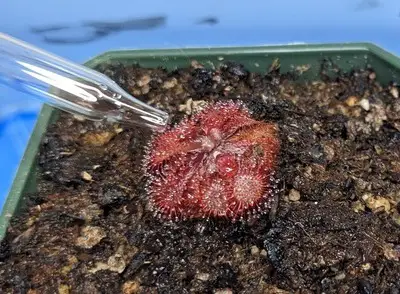You can speed up the growth of your Sundews significantly by feeding them every few weeks.
I have grown and propagated sundews for over 3 years and in this guide I will show you exactly how to feed your Drosera 🙂
Feed a Sundew by dropping tiny insects , fish pellets, of Maxsea fertilizer drops in their sticky leaves. Feeding 2-3 pieces of food in a single leaf every 2-4 week is enough to provide substance and promote growth.
Here is a quick summary and you can keep on reading for the complete explanation 😉
- What to feed sundews: small live or dead insects, such as gnats or mosquitoes, fish food, Maxsea fertilizer drops, or freeze dried insects.
- How often to feed Sundews: Feed your plant once every 2-4 weeks. Skip feeding if it is still digesting the previous meal.
- How much to feed: 2-3 tiny insects in a single leaf are enough to provide substantial nutrients.
Why Do Sundews Need to Consume Insects
Sundews are carnivorous plants that live in very poor growing conditions. Their natural habitat lacks many of the nutrients plants need to survive. For that reason they developed the capability to trap and consume insects.
The insects Sundews consume are important as they provide a lot of nutrients they can’t get from the soil or water. However, it is important to know, consuming insects is not. q hard requirement.
Sundew plants do not require consuming insects to survive. They usually capture their own prey, but if they are unable to do so, they can be healthy without it. The nutrients Sundews extract from insects help promote quicker growth, but are not a requirement for survival.
Even though feeding is beneficial it can be done wrong. feeding sundew incorrectly can kill leaves and even the whole plant so keep on reading for no-fail instructions.
Best and Worst Food for Sundews
Sundews are not picky in terms of food. However, the size is pretty important considering Sundews are usually in the smaller side.
Best Food Options for Sundews
These are some great options to feed your Sundew:
1.- Live or dead small insects: mosquitoes, gnats, fruit flies, ants
I have had best success with small insects as they are easy to digest and can be consumed within a few weeks without attracting mold or pests.
Sundews can consume and extract key nutrients from dead or live insects.
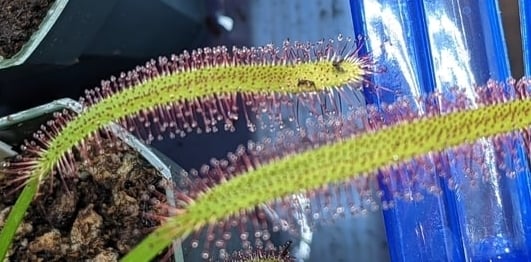
In many cases, I just leave the plants in a windowsill and the sundews are great at catching random gnats on their own.
You can catch live or dead insects on your own or simply buying them at the pet store. Dead insects work better since you will only need one or two every few weeks.
2.- Freeze-dried bugs: freeze-dried insects such as mealworms or bloodworms
Freeze-dried worms are great because they are already dead, inexpensive , and a single container will last you ages. You can check this link to Amazon to check it out. You can also buy these are pet stores or online shops.
3.- Maxsea fertilizer drops
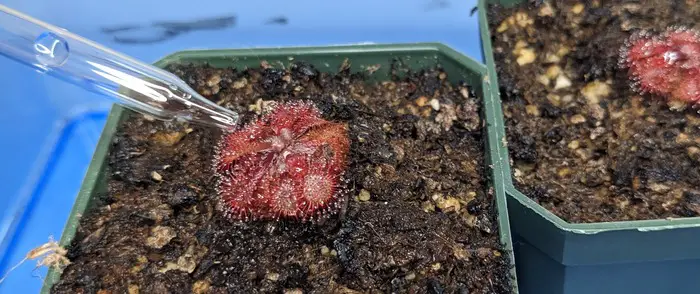
You can dilute 16-16-16 Maxsea fertilizer and add a few drops in a couple of leafs to provide plenty of nutrients. Also, Maxsea is great for fly traps and pitcher plants. Here is a link to check availability and purchase in Amazon.com.
4.- Fish food
Fish foods come with plenty of nutrients. You can break them down and place them in the leaves or dilute with distilled water to create a paste.
Worst Food Options for Sundews
Never give human food such as raw meat, chicken, salami, candy, fruit, or cheese. Sundews won’t be able to consume it and the plant could die or at least lose some leaves. All these are a big no no 😉
- Hamburger
- Chicken
- Sausage
- Salami
- Raw meat
- Candy
- Fruit
- Steak
- Hotdog
- Cheese
Also, never use large bugs for a small sundews. For example cockroaches and large crickets will just remain in the leaf for weeks without digesting them entirely. It is best to stick small insects only.
How to Feed Sundews Step by Step
How to feed a Sundew will depend greatly from the food you chose to use. Here are the instructions for the ones I recommend:
- Live or dead small insects
- Freeze-dried insects
- Maxsea fertilizer drops
- Fish pellets
The links can help you find a place to buy these.
Using live or dead bugs
Feeding insects to Sundews is my preferred method. It is just very easy.
Grab two to three small bugs and stick them to the leaves of your sundew plant. Place the insects in two or three leaves and let your plant digest the bug. It usually takes 2-4 weeks depending on the size.
Feeding a few leaves provides enough substance for the complete plant and lowers risk of the whole plant turning black.
Feeding Freeze-dried insects
Using freeze-dried insects is very practical as you don’t have to go hunt for live bugs.
Freeze-dried mealworms, bloodworms, or crickets are too large for feeding a sundew. But luckily, you can break them down into small pieces. The aim is to feed your plant something as small as a gnat or smaller fly.
Grind freeze fried insects and add a few drops of distilled water. Mix and add more water until you create a paste.
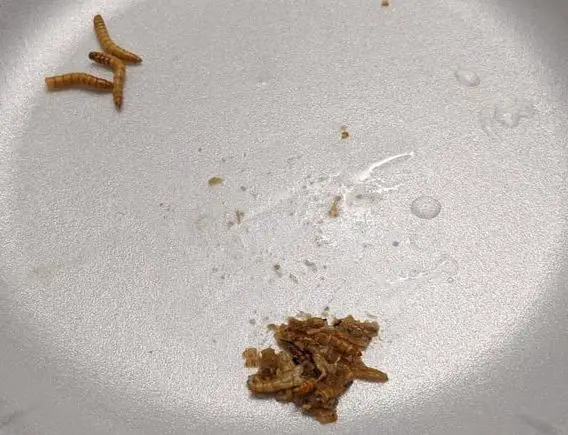
Finally place small drops of the paste in a couple of leaves. 2-4 drops (the size of a grain of rice) are enough.
Making and feeding Maxsea fertilizer drops for your Sundew
Maxsea is a recommended and trusted fertilizer for carnivorous plants. It is also affordable and very easy to prepare.
First, never fertilize the soil of your plant. You will use these fertilizer to drop it in the leaves. Fertilizer in the soil will kill sundews.
Use 1/4 of a teaspoon of Maxsea fertilizer diluted in a gallon of distilled water. Mix well and use a pipette to add 2-3 drops in a couple of Sundew leaves. Repeat once a month for best results.
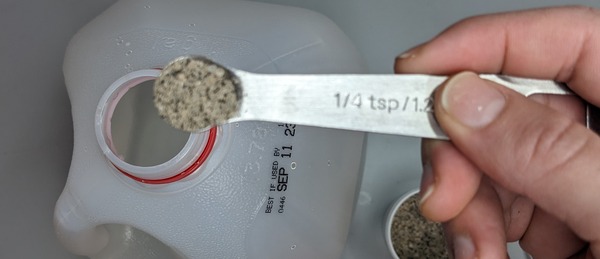
It is sometimes a challenge to keep the drops in the leaves so be very careful and use a pipette or something similar to drop the fertilizer with precision.
Using fish food for feeding
Using fish pellets as food for Sundews is straight forward.
You can break down the pellets into small pieces and place in the leaves or create a paste.
Create a fish food paste by grinding or smashing the food and adding drops of distilled water until the mixture is even. It does not have to be a perfect mixture.
Place the paste or fish food pieces in a couple of leaves 3-4 bits is enough for the whole Sundew. Repeat once the food in completely consumed, which usually takes a month.
Here is a link to fish food you can use.
Sundew Feeding Tips
- Grow your plant outside if you do not want to worry about feeding your plant. Sundews are very effective at capturing prey.
- Avoid using large insects and sticking them to your plant. large insects will stay there for months, attract mold and smell terrible.
- If you do not have the time or energy to feed your plant. Skip it. Sundews do not need the nutrients to survive. your plant can be completely healthy without it.
- Never drop any type of food to the soil of your plant. Nutrients in the soil kill drosera plants!
- Only feed your sundew once every 2-4 weeks and check first of the plant might still be consuming its last meal before feeding.
- When feeding select one or two leaves and add food to those exclusively. Why? Because feeding can cause black leaves. You want to avoid killing multiple leaves at the time and this will prevent it.
Sundew Care 101
Here is a short growing guide on sundews and how to keep them healthy 🙂
Soil: Employ nutrient-free and fertilizer-free potting media. Combining a mixture of peat moss or sphagnum moss with peat or silica sand is an excellent option. Do not use Miracle-Gro. This article lists the best soil options and tips to pot your plant.
Pots: Chose plastic or glazed ceramic pots for your sundew and avoid terracotta and clay. Selecting the wrong pot can end up killing you plant. This article can help you choose the perfect container for your plants.
Lighting: Sundew plants need lots of light. Employ artificial or natural light and provide a minimum amount of 6 hours of light. Optimally, provide 8-12 hours of light.
Temperature needs: Temperarure requirements vary across different varieties of Sundews. Some Drosera undergo dormancy and need a change in climate during the summer or winter months.
Watering needs: Keep the soil humid at all times. Water often or employ the water tray method to keep the soil moist. Here are the complete instructions to water sundews to perfection.
Feeding: Feeding is not required and outdoor plants capture their own food. When feeding, employ bugs and only feed once or twice a month.
Trimming: Trim dead leaves when necessary. Please do not cut off leaves until they have entirely dead.
Humidity needs: Keep humidity levels above 40% and 70%. A humidifier is a practical solution for dry indoor locations.
Use of Fertilizers: Avoid fertilizing to prevent damage.
Outdoor vs. Indoor growth: Assess if your indoor or outdoor environment is the most suitable for your Drosera plant. A good strategy is to research about their natural habitat and try to replicate the environment.
For more information, you can read my additional guides and articles on Sundews.
Recommended Products for Growing Carnivorous Plants
Finding the best pots, lights, and soil for carnivorous plants is difficult. I have grown carnivorous plants for over 5 years, and these are the products I use. The links will take you to Amazon to view the prices and full specs:
- Carnivorous Plant Soil
- Carnivorous plant soil: https://amzn.to/422yLZa
- Artificial Lighting
- Small plant light for 1-2 plants: https://amzn.to/3oQsmSj
- T8 LED light fixture for multiple plants (6500k Cool White): https://amzn.to/3uWoeh2
- Pots and Miscellaneus
- Nursery pots for single plants: https://amzn.to/3oL8YGq
- TDS meter to measure water quality: https://amzn.to/3g8VKLI
- Dried crickets to feed carnivorous plants: https://amzn.to/34QEnKv


